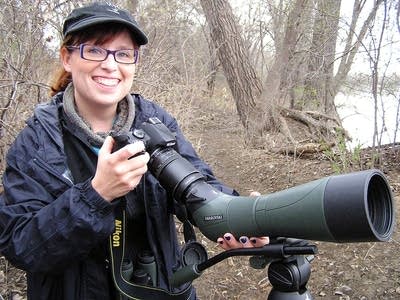Even with human homes ravaged, the sight of a twister-shattered heron rookery strikes a chord
Go Deeper.
Create an account or log in to save stories.
Like this?
Thanks for liking this story! We have added it to a list of your favorite stories.

When the tornado struck north Minneapolis on May 22, my first concern was for friends. Quick checks of social media found those friends alive, although a few had damage to their homes. The following morning, those same friends sent messages, asking why the herons were circling their nesting island in North Mississippi Regional Park.
That park is part of the Mississippi National River and Recreation Area, a national park that is a partnership with the state, the county, regional parks and private landowners to care for 72 miles of the Mississippi as it flows through the Twin Cities. An island right off the bike and pedestrian trail was home to roughly 200 great blue heron nests.
The tornado that spared my friends hit the island and wiped out every single nest.
The adult herons saw the tornado coming. Instinct told them they could not defend the nests from this danger and to fly. If the chicks were there when they returned, the adults would continue to care for them. If not, the adults would live to raise chicks again.
Turn Up Your Support
MPR News helps you turn down the noise and build shared understanding. Turn up your support for this public resource and keep trusted journalism accessible to all.
That instinct meant most of the adult herons survived, and relatively few were injured. But almost all the chicks were killed.
As I stared at the devastated rookery, area residents joined me. They were heartbroken at the loss the large, graceful birds endured and they wanted to help the injured. It's a natural human instinct to want to help, but herons assume that a chasing human wants to eat them. If they think you're about to attack, they will defend themselves violently by jabbing their sharp beak to your eyes.
My park mobilized with the Minnesota DNR and the Animal Humane Society to recover injured adults safely. That operation, combined with the efforts of private citizens, also led to the recovery of nine live heron chicks that are thriving at the Wildlife Rehabilitation Center.
To my surprise, just about every media outlet in the Twin Cities covered the story. Friends who were affected by the tornado were also concerned for the birds and followed my social media updates.
This raises a question. Amidst the loss of human life and, for many people, the loss of homes, why did the community respond to this story about herons?
The beauty of the Twin Cities is that in one day, you can find quiet park space for fishing, boating, painting and biking, among other activities, and cap it off with a night of world class theater or a visit to a bar that hold its own in any Zagat guide. We treasure that lifestyle, and these birds were part of that.
That these prehistoric-looking birds chose to nest in our urban area is a beacon of how we take care of our waterways. These herons were our neighbors. They were landmarks for canoeists, wildlife to share with children, subjects for photographers, program topics for naturalists and a highlight of summer.
A bad storm shakes our very core as we see that our sturdy homes could be treated so casually by wind and hail. We rarely think of what happens to wildlife. Do we imagine that birds fly away and survive? If we notice one robin nest blown away, do we think, "Well, it was just one nest, there are others"?
But this was a loss of several hundred young herons. That amount of destruction to wildlife in a prominent area was not hidden away as a mystery of nature. It couldn't be ignored.
Like many after the storm, the herons are rebuilding. Some went further north on the river to the Coon Rapids Dam, to join an established rookery. Others went south and have rebuilt off of two islands in front of the Riverside Power Plant, just north of downtown Minneapolis. It takes a chick three months to go from an egg to a self-sustaining adult heron ready to migrate. If we have a warm autumn, they could be fine.
It's encouraging to know that the herons still find this a place that offers shelter and abundant food - that this remains a habitat strong enough to raise a family.
----
Sharon Stiteler runs Birdchick.com and wrote the books "City Birds/Country Birds" and "Disapproving Rabbits." She leads bird trips, does bird surveys around the country and works part time as a national park ranger.
Dear reader,
Political debates with family or friends can get heated. But what if there was a way to handle them better?
You can learn how to have civil political conversations with our new e-book!
Download our free e-book, Talking Sense: Have Hard Political Conversations, Better, and learn how to talk without the tension.



